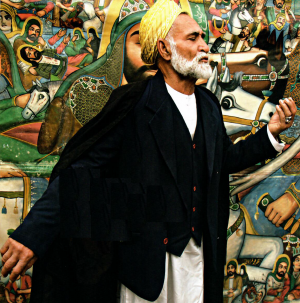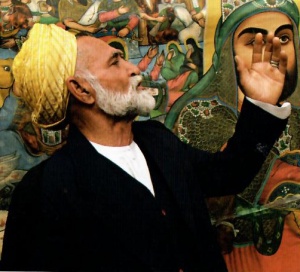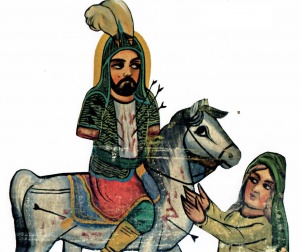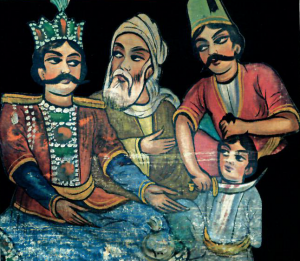Nabiollah bahari
Nabiollah bahari | |
|---|---|
 | |
| Born | 1943 Arak |
| Nationality | Iranian |
| Known for | Pardekhani and Ma'rekegiri |
| Patron(s) | Morshed Khan Ali (his father) |
Nabiollah Bahari (born in 1943) is a prominent Iranian Pardekhan whose style is characterized by austere theatrical movements. He was trained under supervision of Morshed Khan Ali (his father).
Performance Method
He uses a simple style in comparison with other curtain-storytellers, who use quick movements and variation in rhythm in their performance, with the aid of hands, head and neck and legs. In this mode, optimal use is made of energy and time to express the intention to the audience.
Singing Method
In the performance of Morshed Bahari, due to his simple theatrical movement, the singing plays a less important role, and for this reason, the non-melodic recitation and rhythmic narration is used more. At the beginning, of the melodic sections, the tone of voice of the singer narrator has an atmosphere of Mahur mode (Dastgah [1] ) with a hint of the Avaz - e Isfahan [2] [3] (in the second Dong) . Since then after the declamation of the Har ke darad havas e Karbobala (Whoever is longing for Karbala) section the melody refers to Shur Dastgah [4] (Avaz e Abuata) [5] and in the Magar nashnidi to hokm e sardar section because of the epic topic of the poem, the curtain-storyteller stays on one pitch for the first hemistich, and in this way he rightfully expresses the content of the poetry and in the second hemistich the melodies develop and in terms of the performed intervals it establishes an atmosphere of Homayun Dastgah (mode). The singing approaches the Segah Dastgah in Har ke darad havase Karbobala (Whoever is longing for Karbala) the song moves into Shur intervals which remind one of Abuata .The singing approaches the Segah Dastgah in Mara ma'zur dar az dastbusi... (using the third note of the first Dong up to the Shahed). However, the most important particularity of his method is the creation of rapid transitory spaces which evoke the intervals of some Radif music Dastgah without getting away from the declamation of words which from a kind of expression for introducing a specific stable pattern. [6] [7]
Narration
After performing the sections expressing the Holy name, advice, sermon, Morshed Bahari goes on to the explanation of the curtain and the story of the old lady pilgrim and Abbasid caliph, Mutawakkil. The cruel Caliph of Baghdad prevents the pilgrimage of the old woman to the shrine of Imam Hussain, third Imam of the Shi'ites who was martyred in Karbala. Mutawakkil orders that the old woman be thrown into the Tigris river. The woman's prayer to Imam Hussain causes Abbas ibn Ali to rush to her aid to complete her pilgrimage to her Imam.
Source
- Ardalan, hamidreza (2008). Picture-storyteller masters of iran, the Iranian academy of the art, 2008, volume 15. ISBN: 978-964-2986-033(vol.15). 978-964-2986-002(set).
Reference
- ↑ Mahur Dastgah only in terms of the intervals within the first two Dongs is comparable with the major scale in European music and the Avaz-e Bayat-e Isfahan is a melody near to the minor scale in European music .
- ↑ The word 'Avaz' has two meanings: 1- Song or verses performed by a singer 2-A kind of general form in Iranian music which can have smaller subsidiary forms within it (with a specific metre or free metre), with or without a singer. The five Avazes of Iranian music repertoire are: Abuata, Bayat e Tork (which is also called Bayate-Zand or Bayate-Qajar), Afshari, Dashti, and Bayate-Isfahan. These are not independent, and on account of their figure-melodies, intervals and final notes and...are related to one another, Abuata, Bayat e Tork, Afshari and Dashti are related to Shur Dastgah and Avaz-e Bayat-e Isfahan is related to Homayun Dastgah. Avazes in terms of extension are smaller than the Dastgahs, and are made up of two or three tetrachords .
- ↑ In Iranian music, Alinaghi Vaziri for the first time introduced the accidentals: Koronp for interval between the natural and the flat, and Sori for an interval between the natural and the sharp. It should be noted that in theory in Iranian music these accidentals are considered as quarter tones but in practice they are usually more or less than this amount. Here, to simplify matters we show the lesser intervals with-sign and those exceeding the quarter tone with+.
- ↑ In Mirza Abdollah's Radif, the Pishdong of Shur Dastgah is performed with omission of the first and second pitches but in other vocal and instrumental Radifs like Aqahosseinqolis Radif, Saba's Radif and Abdollah Davami's vocal Radif, and ... the Pishdongs are completely performed .
- ↑ Among the four Avazes related to Shur Dastgah,the Abuata Avaz is nearest in terms of similarities . For this reason, during the performance of Morshed Nabiollah, the possibility of distinguishing between the Shur Dastgah and Abuata Avaz is lost.
- ↑ The type-melodies which with development and expansion make up the units called Gushes having a central note called Shaned . In the first Gushe in each Dastgan the final note is the same as Shahed note. However, in the next Gushes , for technical reasons this can be changed according to rules.
- ↑ The last note in each Gushe is called Ist. In the beginning Gushes (Daramad) that are most important in each Dastgan the is! note is the same as the Shahed note. Those Gushes which themselves have a separate Shahed generally have a common ist note with the Daramads . Sometimes depending on the melodies movement this can be changed. 8. The basis of Iranian Dastgah music are related to tetrachords called Dongs. The most important note is called Shahed. This! note is the starting point of one tetrachord. Also, the notes preceding the Shahed note which are generally the size of one tetrachord are called Pishdong.



